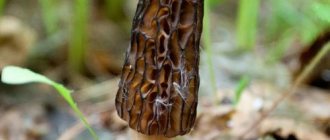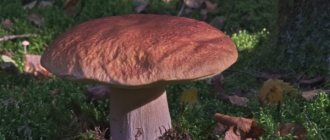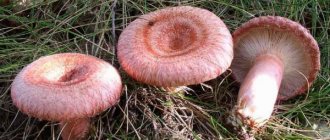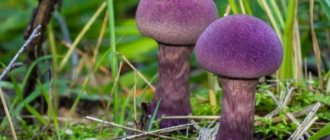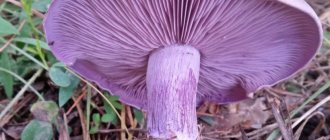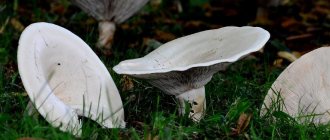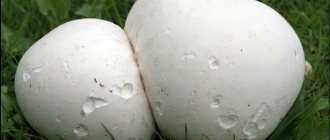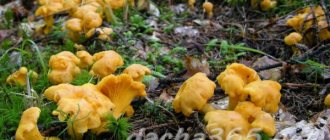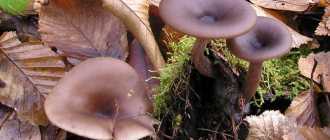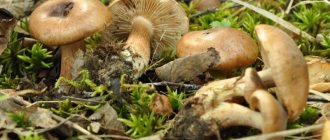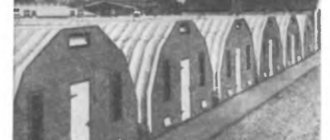In this article you will learn what edible and poisonous row mushrooms are.
Autumn is mushroom time. All lovers of quiet hunting go to the forest to walk along the paths between the trees and collect a basket of mushrooms.
- Some mushrooms go straight into the basket, since the mushroom picker knows for sure that they are edible.
- Inexperienced mushroom pickers are afraid of other mushrooms, despite the fact that they are edible. Such mushrooms include row mushrooms, since this species contains poisonous individuals masquerading as normal mushrooms that should not be eaten.
- There is an edible, conditionally edible and poisonous variety. You will learn how to distinguish edible from poisonous rows in this article.
Description and differences
Even edible representatives of this species must be thoroughly cooked before being eaten. At the same time, they are very similar to their poisonous counterparts. Let's consider the distinctive features of edible and poisonous rows:
- Poisonous species have smooth caps, only white in color, and they give off an unpleasant, pungent odor.
- Edible rowers can have different caps: lilac, gray, pink or purple . The legs match the shade of the cap. The plates under the cap are bright yellow, the cut flesh is the same color as the plates.
- Friendly groups of mushrooms can be found in the fall (September-October) and especially after the first autumn frosts. Their favorite places to germinate are soil among moss or the surface of the forest floor.
Who does she look like?
The closest relative of the Ryadovka is the yellow-brown Ryadovka.
Row yellow-brown
Based on the name, it has a brown color and a very similar appearance. However, up close there are a number of differences.
The scaly rowan is more fleshy, unlike other species similar to it. Brown, white and leopard Ryadushka are classified as poisonous mushrooms with a pungent odor. With a wide variety of species, it is quite difficult to identify a non-poisonous representative in a clearing.
Varieties of edible rows
Violet (Lepista nuda)
A mushroom from representatives of the Ryadovkov family from the Lepista genus. It is also called violet lepista or naked. In common parlance it is sometimes called titmouse for its lilac-blue color. This mushroom is conditionally edible.
- The hat can reach 20 cm in diameter. Initially, its shape is hemispherical (like a bun), but during ripening it becomes flat, and the edges are thin and curved.
- The color of the cap is brownish-violet, becoming lighter as it grows, starting from the edges. To the touch it is dense, fleshy and elastic. It is smooth and moist, shiny in places.
- The pulp is firm, thick, has a pleasant taste and smell. The shade is marbled, lilac-blue, which fades over time.
- The plates are thin and frequently located. Their color varies from bright purple to light purple.
- The leg has the shape of a cylinder, reaches a height of 10 cm, and a diameter of 0.7 to 2.5 cm. It is bright purple in color at the beginning of growth and whitish or lavender towards the end, its surface is fibrous.
- The purple row grows in coniferous forests (less often in mixed ones) in the temperate climate of the Northern Hemisphere (European Russia, Siberia). Not whimsical.
- Collection can be carried out from the beginning of September until the end of November, before the onset of the first frost.
- Before consuming the purple row, it must be boiled for 10-20 minutes.
Important! This mushroom has an inedible counterpart - goat's web. It tastes bitter, has a musty odor and yellow flesh.
Gray (Tricholoma portentosum)
- Grows in groups in coniferous or mixed forests.
- Collection season is September-November.
- The cap reaches a diameter of 5-12 cm, sometimes 16 cm. Its shape is convex-bell-shaped, and in the process of maturation it turns into a convex-prostrate one. The surface is grayish brown in the center, sometimes violet or olive tinged, and the edges are light gray or cream. The radial fibers in the middle are darker. Often there is a flat tubercle in the center of the cap.
- The short, grayish-yellowish leg reaches 5-12 cm in height and 1-2.5 cm in thickness, thickened at the base, covered at the top with a powdery coating.
- The pulp is solid at the beginning of growth, later grooved, dense, and has a whitish tint. A mealy smell and taste is characteristic of young specimens, and over time the aroma becomes even pungent. The flesh under the skin of the cap is gray.
- The plates are free or straight and attached by a tooth to the stem. They may be white, cream or grey-yellow, with yellowish spots as they age.
- Mushrooms are edible, but they need to be boiled in two waters to remove the pungent odor. It is better to collect young specimens. Cook like this : boil, fry or pickle.
Gray grass can be confused with soap bark (Tricholoma saponaceum). It is similar in shape and color, but at a young age. They can be distinguished only by the specific soapy smell of the pulp.
Crowded (Lyophyllum decastes)
- It grows in large groups in forests, parks, gardens, on lawns, near stumps, in soil rich in humus.
- Collection season – July – October.
- The hemispherical cap can reach a diameter of up to 4-14 cm, becoming convex as it grows. These mushrooms grow so densely that their bases are sometimes difficult to separate.
- The cap can be brown or gray-brown, the edges are downward, wavy. The surface itself is uneven and bumpy. Often a wide tubercle is located in the center.
- The leg reaches a height of 4-10 cm, and a thickness of 6-20 cm, it can be curved or compacted. Completely white at the top, and towards the bottom it can acquire a light gray or gray-brown tint.
- The pulp is white, has a pleasant taste and smell, and is thickened in the center.
- The narrow plates are adherent and frequently located. They are white or off-white in color.
- Ryadovka crowded belongs to category 4 edible mushrooms. Description of preparation : they can be fried, salted or pickled.
The twisted row is similar to the poisonous yellowish-gray entoloma (Entoloma lividum) . Their similarities are in the cap, which has wavy edges and the same gray-brown color. These 2 types of mushrooms differ in that the entoloma pulp has a specific smell of flour and it grows individually, and not as a row in a large group.
Pigeon (Tricholoma columbetta)
- Lives in deciduous or mixed forests, prefers humid areas. They can grow either in a group or alone.
- Collected from July to October.
- The cap is dry, smooth, grows in diameter up to 3-10 cm, sometimes up to 15 cm. At first it is hemispherical, and as it grows it becomes convex and prostrate. Its surface is lumpy or strongly wavy, white-cream or ivory. This is the most significant difference between this type of mushroom. There are yellowish spots in the center.
- The leg can be 5-12 cm in height, up to 2.5 cm in thickness. It is dense and elastic, has the shape of a cylinder, slightly narrowed towards the bottom.
- The flesh of the pigeon row is dense and fleshy, as it grows it becomes pink , and also turns pink at the break. The smell is mealy, and the taste is pleasant mushroom.
- The plates are attached to the stem, and then free, often located.
- This is an edible mushroom (category 4), it can be boiled and fried.
At the initial stage of growth, pigeon row is similar to gray row, also edible, but with a different pleasant aroma. During the growth process, the changes are more noticeable due to the gray color of the cap on the gray row.
Yellow-red (Tricholomopsis rutilans)
- They are found in large groups in mixed or coniferous forests. They prefer rotten pine or spruce stumps and fallen trees.
- Collected from July to September.
- The hat can reach 5-15 cm in diameter. Initially, it has the shape of a sharp bell-shaped cap. As it grows, it becomes convex with a tubercle in the center, and the edges bend down. Mature specimens have an outstretched cap, with a slightly depressed center. The difference between this species is the red-cherry color of the cap on young mushrooms and the yellowish-red color on more mature ones. A dull bump that becomes depressed over time, always of a darker shade.
- The leg reaches 4-10 cm in height, and can be up to 2 cm thick. It has a cylindrical shape, with a thickened base, often hollow inside. At the base the leg is yellow with red scales, the middle part is more intense in color, the rest matches the color of the cap.
- The pulp has a sweetish taste and a slight sourish odor. It is dense and fibrous, yellow in color with light cream spores.
- The plates are adherent, thin and tortuous, golden or egg- yellow in color.
- This species is edible, belongs to category 4, and can be pickled or salted.
The yellow-red row is a rare species, in some regions it is listed in the Red Book.
How does a mushroom bear fruit?
Grows in temperate climates, mixed or coniferous forest. Selects sunny edges, open forests, settles near paths and roads, and grows in large groups. It is harvested mainly from early summer to mid-autumn. Maximum yield is observed in September.
If the weather is warm and sunny, then I begin to harvest the first harvest from the beginning of August.
You cannot collect mushrooms in an industrial zone, roadside area, abandoned mine, landfill, or places where chemical and agricultural waste is disposed of.
Inedible types of rows
Pseudowhite (Tricholoma pseudoalbum)
- Lives alone or in small groups in mixed or deciduous forests.
- Grows from August to October.
- The cap is hemispherical at the beginning of growth, later it becomes convex, reaches a diameter of 3-8 cm. Its color is white, cream or slightly pinkish.
- The leg grows up to 3-9 cm in height and 1.5 cm in width. It is the same shade as the cap: white, pinkish or creamy white.
- The pulp has a mealy odor, is white at first, then slightly yellowish.
- The plates are cream-colored, at first slightly grown in, and then almost free.
- It has an unpleasant taste, so it is not eaten.
This species is similar in shape and size to Mayweed (Tricholoma gambosa). But the latter has greenish or soft pink areas on the cap.
Stinky (Tricholoma inamoenum)
- Grows in groups or singly in humid areas of deciduous or mixed forests.
- The growing season is from June to October.
- The cap usually reaches 3-8 cm in diameter, but can grow up to 15 cm. Its surface is smooth, often lumpy, ivory or white, and as it grows, brownish or yellowish spots appear. At the beginning of growth, the cap has a hemispherical shape, and with age it becomes convexly spread, with slightly wavy edges.
- The length of the leg grows up to 5-15 cm, and the thickness up to 2 cm. It has a cylindrical shape, elastic and dense, the color is identical to the cap.
- The white flesh is fleshy and dense. Representatives of this species are distinguished by a strong stinking odor, which is characteristic of both young and old mushrooms. The smell is similar to lamp gas.
- The adherent plates of medium frequency can be white or cream in color.
- Due to the stench, these mushrooms are not edible. Even cooking does not eliminate it.
Often, at the beginning of growth, you can confuse the stinking row with edible sulfur (Tricholoma portentosum). But it lives up to its name and the stinky smell is hard to miss. And the gray row has a pleasant mushroom aroma.
How to prepare scaly rows
Since the sweet has a special bitter taste, you need to learn how to cook it correctly. In this regard, it is worth familiarizing yourself with some recommendations:
- To begin, the fruiting bodies must be soaked in salted cold water for 3 to 5 hours. During this entire period, you need to change the water at least once.
- Then the scaly row must be boiled at least 2 times for 15 minutes.
- After this, the preparation can be added to various dishes, frozen, stewed, fried and baked.
Important! This mushroom is not suitable for drying, because when cooked it produces bitterness, which can harm the body and provoke symptoms of poisoning.
Beneficial features
Edible rows are a dietary and very healthy product. It promotes liver regeneration, has a positive effect on the functioning of the gastrointestinal tract, and removes waste and toxins from the body.
The rich chemical composition of mushrooms:
- from vitamins: group B, A, K, PP, C, D2, D7 and betaine;
- from minerals: sodium, potassium, phosphorus, iron, zinc, manganese;
- from amino acids: threonine, alanine, phenylalanine, lysine, glutamic, stearic and asperganic acids;
- phenols;
- clitocin and fomecin, which are natural antibiotics and fight cancer cells and bacteria;
- flavonoids;
- polysaccharides;
- ergosterol.
Chemical analysis of edible row mushrooms confirms their anti-inflammatory, antiviral, antibacterial, antioxidant properties and positive effect on the immune system.
In addition, in the complex treatment of certain diseases, mushrooms have a positive effect. At:
- diabetes mellitus;
- arrhythmias;
- rheumatism;
- osteoporosis;
- surges in blood pressure;
- oncological diseases;
- diseases of the genitourinary system;
- diseases of the nervous system.
Benefits and harm to the body
The scaly row has many useful properties. Among them are:
- Application in medicine. The enzymes contained in the fruiting bodies are used to make antibiotics to treat tuberculosis patients.
- High content of vitamins. The scaly rows contain a whole complex, which includes vitamins C, B, A and PP.
- Help with mental fatigue. Sweetie helps enrich the blood with oxygen, which has a positive effect not only on the brain, but on the entire body as a whole.
- The mushroom is also useful for patients with hypertension and diabetes. Suitable for dietary nutrition due to its high protein content. Can be a complete meat replacement for vegetarians.
- Improves digestion, boosts immunity, helps get rid of chronic fatigue, restores the walls of blood vessels, and cleanses the body of toxins.
Important!
Traditional medicine uses this species to prepare lotions and ointments that promote wound healing and the treatment of skin diseases. Of the unfavorable aspects that may arise when using scaly rows, only the following can be identified:
- Individual intolerance to the product.
- Exacerbation of ulcers and gastritis due to improper preparation of sweets.
This video will help you get to know the scaly row more closely:
Symptoms and signs of poisoning
Symptoms of poisoning by inedible mushrooms, as well as other poisonous mushrooms, are very similar. They appear 1-3 hours after eating mushrooms:
- pain in the stomach;
- weakness;
- increased salivation;
- vomit;
- diarrhea;
- nausea;
- headache.
Poisonous rows often do not cause delusions, hallucinations and confusion. But even when the first symptoms of this nature appear, you need to consult a doctor.
Spreading
The row is poisonous.
The poisonous row is widespread throughout the northern hemisphere within temperate climates, but is not common. This fungus preferably lives on calcareous soils. Capable of forming mycorrhiza with any tree species, but prefers conifers. Growth is usually either singly or, as is typical for rows, concentrically (so-called “witch circles”).
Interesting Facts
- Row mushrooms are considered a delicacy in many countries. Therefore, some of them are grown as export products.
- Growing at home is similar to growing champignons and is not difficult.
- In cosmetology, powder from the dried fruiting bodies of the fungus is often used. They are added to various products that help fight excess oily skin and acne.
- The Japanese matsutake mushroom is valued as highly as the European truffle. This fried mushroom is an expensive delicacy, with some specimens costing around $100.
Watch the video! White row in the forest. How to recognize
Distinctive features of a poisonous mushroom
The poisonous mushroom has a number of features that help distinguish an edible mushroom from a dangerous one:
- The cap of the poisonous row is covered with dark gray scales; they are heterogeneous and resemble roof tiles.
- The plates of the hymenophore are wide, fleshy, of medium frequency, with small plates located between them.
- In mature mushrooms, the plates constantly secrete water-mucous drops.
- When broken, the color of the flesh does not change. In addition, it has a pleasant smell (and not a sharp mealy one, like the edible one). The taste of bitterness is not felt either.
- Poisonous individuals are not gnawed by worms, and insects practically do not land on them.
Irina Selyutina (Biologist):
Tiger or leopard row is a mycorrhizal fungus that is found in coniferous and less commonly in deciduous (beech) forests. Prefers to settle on forest edges. For normal life it needs calcareous soils.
The poisonous rower is similar to the gray rower, but it has a uniform cap color without prominent dark scales. The white cap distinguishes the inedible mushroom from the white champignon. In addition, he has a distinctive, clearly visible ring on his leg.
In the edible species, the row is black-scaled, the plates descend onto the stem. The red row (pink) is distinguished by lighter (olive) scales and plates of a pinkish tint.
There is debate as to whether the white grass is poisonous. In some sources it is classified as a weakly poisonous species. Eating it can cause intestinal disorders due to excessive appetite. Others classify it as a completely inedible mushroom and do not recommend eating it.
The persistent unpleasant odor of the mushroom does not disappear even after heat treatment, which confuses mushroom pickers. Usually it is the representatives of the edible species of the rower that smell unpleasant, but the white rower is poisonous.
Spotted rower (Tricholoma pessundatum)
Taxonomy:
- Division: Basidiomycota (Basidiomycetes)
- Subdivision: Agaricomycotina (Agaricomycetes)
- Class: Agaricomycetes (Agaricomycetes)
- Subclass: Agaricomycetidae (Agaricomycetes)
- Order: Agaricales (Agaric or Lamellar)
- Family: Tricholomataceae
- Genus: Tricholoma (Tricholoma or Ryadovka)
- Species: Tricholoma pessundatum (Spotted rower)
- Other names for the mushroom:
- Row wavy-pedunculated
- The row is ruined
- Speckled row
Other names:
Speckled row
The row is ruined;
- The row is wavy-pedunculated;
- Gyrophila pessundata.
Spotted rower (Tricholoma pessundatum) is an inedible mushroom from the Ryadovkov family (Tricholomaceae), belonging to the genus Ryadovok.
Primary processing and cooking recipes
After collection, the mushrooms are sorted, debris and wormy fruiting bodies are removed, washed, and boiled for 15–20 minutes. Soaking is necessary to remove the bitterness that occurs in some specimens.
The resulting broth is drained. After this, they are consumed boiled, fried, stewed, but more often they are salted and pickled. Mostly young caps are used for food.
Salting
Ingredients:
- mushrooms – 1 kg;
- salt – 45–55 g;
- seasonings (dill, onion, garlic, horseradish) - optional.
Preparation:
- Rinse the boiled mushrooms, drain in a colander or sieve, and remove excess water.
- Place in a saucepan or other container.
- Add salt. Add seasonings.
- Put under oppression.
Mushrooms are ready in 7–8 days. Store in a well-ventilated place at a temperature of 5–6 ºС or in the refrigerator.
Pickling
To prepare the marinade per 1 kg of mushrooms you will need:
- water – 400 ml;
- salt – 1 level teaspoon;
- citric acid - on the tip of a knife;
- allspice peas – 6 pcs.;
- bay leaf and clove buds - 3-4 pcs.
Preparation:
- Prepare salted water (2 tablespoons per 1 liter of water), boil the mushrooms in it, drain the fruiting bodies in a colander, and cool.
- Boil the marinade mixture for 20-30 minutes over low heat.
- Cool and add 70 ml of 8% table vinegar.
- Place the fruiting bodies in jars and pour marinade over them.
The rows are edible 3-4 weeks after pickling.
